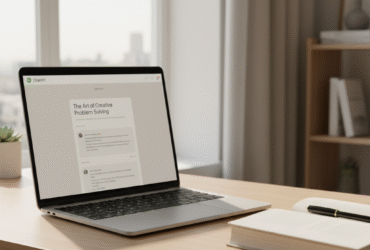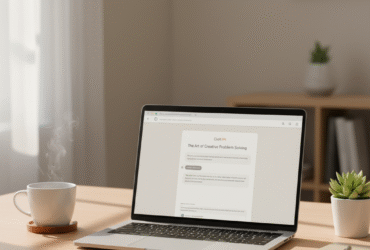How often have you tried to “study like you used to” only to realize your brain—and your schedule—doesn’t work the same way it did in college? Many adults rediscover learning when they pursue career development, personal growth, or even hobbies. But here’s the challenge: the old cramming methods don’t fit the realities of adult life.
I’ve been there myself. When I returned to structured learning in my thirties, I found flashcards and all-night study marathons nearly useless. What I needed wasn’t more effort—it was smarter, calmer strategies that respected my brain and my time.
That’s what this guide is about: practical, science-backed study methods for adults who want to learn deeply, without burning out.
Why Study Methods for Adults Are Different
Studying as an adult isn’t the same as when you were 18 with boundless energy and minimal distractions. Adults bring both advantages and challenges to the table.
- Advantages: richer experiences, stronger reasoning skills, clearer motivation.
- Challenges: limited time, competing priorities, mental fatigue.
The good news? With the right methods, you can maximize your learning power—even in just 30 minutes a day.
Key takeaway: Adults don’t need to study harder; they need to study differently.
The Best Study Methods for Adults

1. Active Recall & Retrieval Practice
Active recall is one of the most powerful ways to cement learning. Instead of re-reading notes, you test yourself—forcing your brain to retrieve information.
- Cover up your notes and quiz yourself.
- Use flashcard apps like Anki or Quizlet.
- Summarize a concept out loud, as if teaching a friend.
When I switched from re-reading to self-testing, I cut my study time in half while remembering more long-term.
Key takeaway: Testing yourself beats re-reading every time.
2. Spaced Repetition
Adults don’t have hours to waste—so make each review session count. Spaced repetition ensures you revisit material at increasing intervals, strengthening memory.
- Day 1 → Review new info.
- Day 3 → Review again.
- Day 7 → Another round.
- Day 14 → Final refresher.
This method is perfect for languages, certifications, or anything you need long-term recall.
Key takeaway: Spaced repetition makes knowledge stick without endless repetition.
3. Chunking & The Rule of Three
Overwhelm happens when you try to absorb too much at once. Chunking breaks information into smaller, meaningful parts.
- Group concepts into 3s.
- Use mind maps to visualize relationships.
- Apply the “rule of three” in note summaries.
Think of it like grocery shopping: easier to remember three clusters (produce, dairy, grains) than 27 separate items.
Key takeaway: Chunk knowledge into bite-sized groups—it’s how your brain naturally organizes.
4. The Pomodoro Technique (with an Adult Twist)

The Pomodoro method (25 minutes focus + 5 minutes rest) isn’t just for productivity—it’s gold for studying. But as adults, we may need longer stretches for deep work.
- Try 40/10 sessions instead of 25/5.
- Use breaks for mindful breathing instead of scrolling.
- Track completed sessions as mini wins.
I often do 3 Pomodoros before lunch—enough to make real progress without draining energy.
Key takeaway: Structured focus beats endless study marathons.
5. Interleaving: Mix, Don’t Block
Instead of studying one subject endlessly, mix topics. Research shows interleaving—alternating between skills—boosts mastery.
For example:
- 20 minutes on vocabulary
- 20 minutes on grammar
- 20 minutes on conversation practice
This feels harder in the moment but pays off in stronger learning.
Key takeaway: Mixing skills trains your brain to adapt, not memorize.
6. Reflection & Journaling for Learning
One overlooked study tool for adults? Reflection. Taking 5 minutes to write what you learned, why it matters, and how it connects to your goals builds deeper understanding.
- Write a daily “learning log.”
- Use prompts: What clicked? What’s unclear? How will I apply this?
- Revisit logs weekly for insight.
I’ve found reflection transforms studying from “getting through material” into meaningful growth.
Key takeaway: Reflection turns learning into wisdom.
7. Digital Tools & Apps for Adult Learning

Technology makes studying easier than ever—if you choose wisely.
- Notion → organize study notes.
- Readwise → sync and review book highlights.
- Evernote → store and search ideas.
- Audible → turn commutes into study time.
Key takeaway: The right tool reduces friction, making study flow natural.
8. Mindful Study Practices
Adults often bring stress into their study sessions. Mindfulness can reduce that tension and sharpen focus.
- Begin with 2 minutes of deep breathing.
- Keep your phone in another room.
- Use ambient music or white noise.
The more present you are, the less you “push” and the more you absorb.
Key takeaway: A calm mind learns better than a frantic one.
9. Collaborative Learning
Even as adults, we learn best with others. Study groups or accountability partners create momentum.
- Schedule weekly check-ins.
- Teach each other concepts.
- Share summaries instead of long sessions.
I once joined a small group for a certification—we all passed faster than studying alone.
Key takeaway: Learning with others builds accountability and deeper understanding.
Conclusion
Studying as an adult isn’t about grinding harder—it’s about choosing smarter methods. From active recall to reflection journaling, these strategies align with how our adult brains and schedules work best.
If you try one thing, make it this: study in short, focused bursts, and reflect on what you learn. That small shift alone can transform the way you learn.
For your next step, I recommend checking out my post: “Why I Stopped Using Flashcards” — it dives deeper into how to replace outdated methods with strategies that truly work.
And if you’d like a tool to organize your notes and reflections, I suggest trying Notion. it’s been the single most useful tool in my learning journey.





